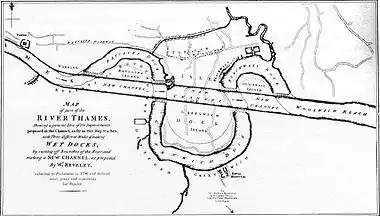Willey Reveley
Willey Reveley (1760–1799) was an 18th-century English architect, born at Newton Underwood near Morpeth, Northumberland.[1] He was a pupil of Sir William Chambers,[2] and was trained at the Royal Academy Schools. In 1781-2 he was employed (under Chambers) as assistant clerk of works at Somerset House.
Around 1788, Reveley travelled in Greece to make sketches for Sir Richard Worsley.[3] That year, he married Maria James, better known under her later married name of Gisborne as a friend of Mary and Percy Bysshe Shelley. Maria's father opposed the marriage and refused to help the couple financially. They returned to England, where they lived on an income of £140 a year. Their son, Henry Willey Reveley (1788–1875), became a civil engineer and architect in Cape Town and Western Australia.[4][5] Their other son's name is unknown.
Reveley was a strong liberal and became a friend of William Godwin and Thomas Holcroft. About 1791 he received his first professional fee as an architect, £10, for assisting philosopher Jeremy Bentham in preparing architectural drawings for Bentham's scheme for a Panopticon prison.[4] Reveley continued to work on the project with Bentham for the rest of the 1790s.
Reveley contributed some views of the Levant to the Museum Worsleyanum (1794), the catalogue of Worsley's collections; and, also in 1794, edited the third volume of James Stuart's Antiquities of Athens.[6]

In 1796, Reveley made four proposals to straighten the River Thames between Wapping and Woolwich Reach in east London.[7] A new channel across the Rotherhithe, Isle of Dogs and Greenwich peninsulas would reduce the river's length, improve flow to remove pollution, and simplify navigation. Three large horseshoe bends of the river would have been left as huge wet docks, connected to the new channel through locks.[8] Parliament rejected all four proposals.[6]
Like the Thames scheme and the Panopticon prison, Reveley's designs for a public bath complex at Bath and an infirmary at Canterbury did not come to fruition.[6][9] His completed projects were All Saints' Church, Southampton (constructed 1792–5, destroyed in 1940);[6] and Windmill Hill, Sussex, a country house built for W. H. Pigou and completed in 1798.
He died on 6 July 1799 "[a]fter a few hours illness".[6]
References
- C. W. Hind, Reveley, Willey (1760–1799), Oxford Dictionary of National Biography, Oxford University Press, 2004 (available online, subscription required).
- Walton, Francis R (October–December 1962). "Gennadeion Notes, I". Hesperia: The Journal of the American School of Classical Studies at Athens. 31 (4): 405. doi:10.2307/147240. JSTOR 147240.
- Kaloustian, David (2007) [First published 2004]. "Gisborne [née James; other married name Reveley], Maria (1770–1836)". Oxford Dictionary of National Biography (online ed.). Oxford University Press. doi:10.1093/ref:odnb/10780.(subscription required)
- Lewi, Hannah (2003). "Exhibiting antipodean narratives: tracing the Perth museum site". In Giebelhausen, Michaela (ed.). The Architecture of the Museum: Symbolic Structures, Urban Contexts. Manchester University Press. p. 60. ISBN 978-071905610-9.
For example, Henry Willey Reveley - Jewell's predecessor as the colony's architect - was the son of Willey Reveley who had worked directly with Jeremy Bentham in designing and drawing a number of his architectural propositions such as the 'Penitentiary Panopticon' illustrations of 1791.
- Ford, George H (August 1952). "Review of Maria Gisborne and Edward E. Williams: Shelley's Friends: Their Journals and Letters by Frederick L. Jones". Modern Philology. 50 (1): 70. doi:10.1086/388942. JSTOR 435236.
- Nichols, John (1815). "Obituary of Mr. Willey Reveley". The Gentleman's Magazine. Vol. 86. p. 627. Retrieved 29 September 2015.
- Forrow, Alexander (1877). The Thames and Its Docks: A Lecture. Spottiswoode. pp. 41–42. Retrieved 29 September 2015 – via Internet Archive.
- Clout, Hugh D, ed. (1991). The Times London History Atlas. Times Books. p. 169. ISBN 978-072300342-7.
- "Willey Reveley and the Bath Pump Room". The Architect: 118. 23 February 1878.